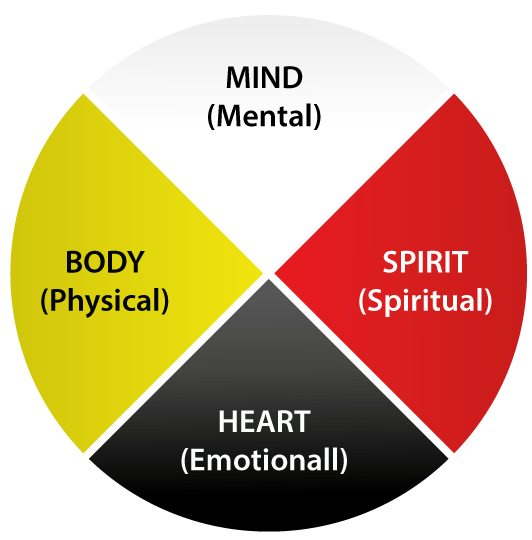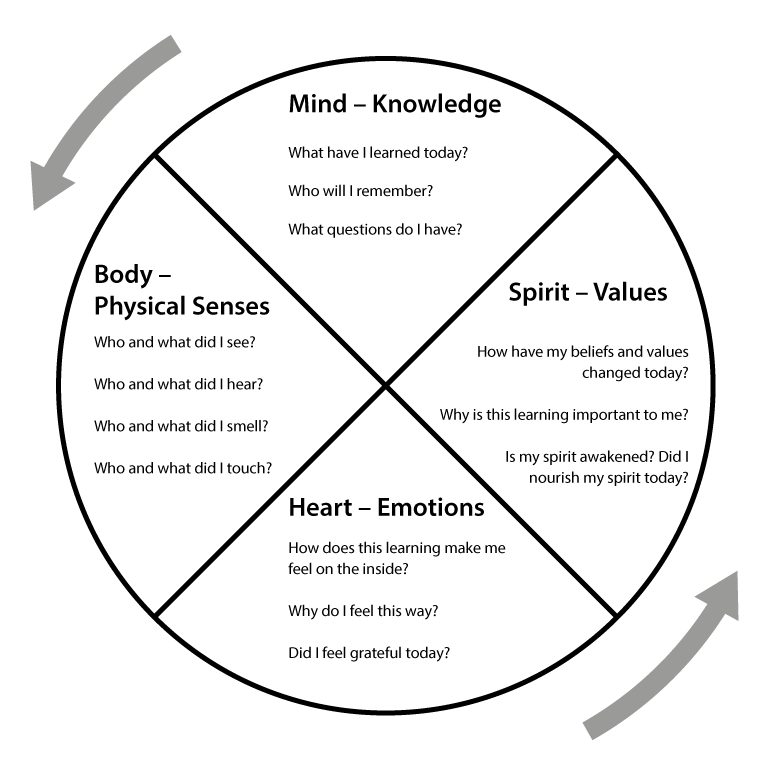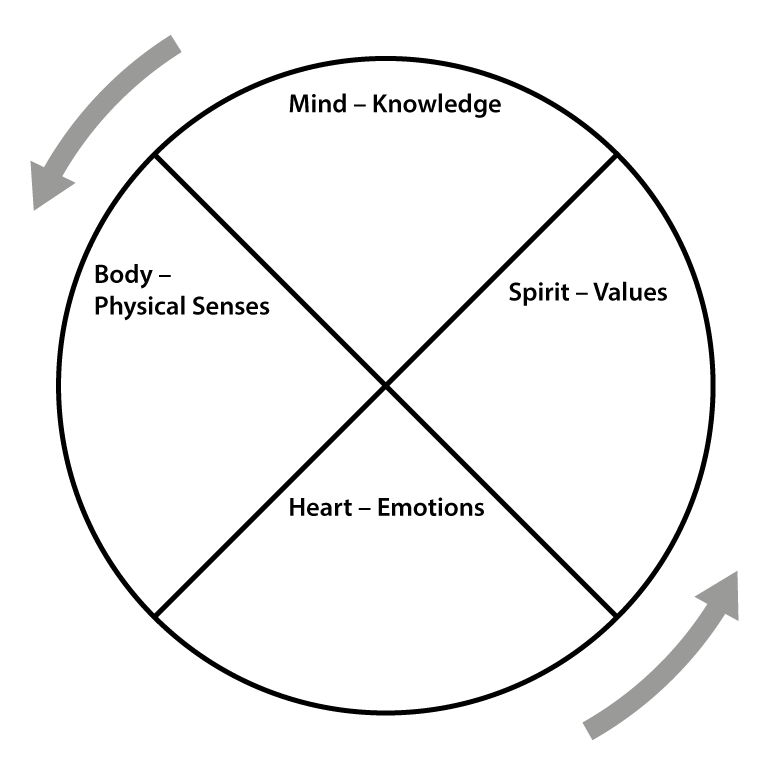Duration
2 class periods (90-100 minutes)
Objective
Students will go on a Nature Walk to observe nature, watch for relationships in nature, use their senses, and connect holistically.
*If you need to travel off school grounds, parental permission may be required. Please check with your school administrators.
**It is recommended that you offer gratitude and ask permission to enter the trail, woods, garden or park you visit, as it is a sacred space. (Sometimes, the entrance will not be clearly defined. That is ok. Just use your judgement.) This type of ceremony can simply be a moment to recognize that you will be entering the home of other beings. Similar to when you enter a friend’s home, you should ask permission to enter respectfully into the woods. Recognize that you will be gifted with beauty and teachings and that you should leave the woods in the same or better condition than you entered. This is about having a reciprocal relationship with land and creation.
Materials
- Appropriate outdoor clothing
- Paper & Pens/markers
- Print out of Holistic Learning Map (Supplemental Materials for Lesson Plan A, Activity 3)
- Special object (rock, leaf, flower, etc.) for sharing circle
- Blankets or cloth grocery bags for sitting on outside (Optional)
- Treaty Education Notebook or blank paper
Class 1
Opening (10 minutes)
Introduce the Nature Walk activity and distribute the Holistic Learning Map worksheet (in Supplementary Materials for Lesson Plan A, Activity 3) to students. Take a moment to explain what the term “holistic” means. You may want to do this inside while students are at their desks/tables, and then move outside.
Nature Walk (25 mins)

- Take the students to a local trail, wooded area, garden, or waterfront park – anywhere local where they can be in nature.
- Before the students disperse, say some words of gratitude and ask permission to enter (as described above).
- Each student should have a copy of the Holistic Learning Map worksheet. This is a holistic learning activity. The students are to think about and jot down some of their observations and reflect on how their experience in nature affects them spiritually, emotionally, physically, and mentally.
- The activity is to be done by themselves and supervised by the teacher. They are to go off on their own, within teacher’s sight, and complete their form. It should be done with as little group interaction as possible.
- We recommend encouraging the students to find a spot to sit to do this activity. The less they move, the more they will be attentive to their other senses and able to observe more in the environment around them.
- Have them sit quietly in one spot, with little movement, for at least 20 minutes. Have them:
- Observe nature around them. What do they see, hear, feel, smell?
- See if they notice any relationships. (Some examples include lichen or fungi growing on trees; new plants growing out of fallen trees; spider webs attached to plants, rocks, etc.; insects or animals eating, drinking, gathering.)
- Close their eyes and breathe deeply. How does this change what they hear, feel and smell?
- Take a few minutes to jot down observations and reflections on the Holistic Learning Map.
- You might want to complete the worksheet as well, so you can lead the students by example in the lesson closing sharing circle.
Lesson Closing (10-15 minutes)
Bring the class back together, either outside or inside, and explain that the next class will be spent in a sharing circle so that students can share about their experiences on the Nature Walk. As a class, find a tree to give gratitude to for air, warmth, shade, and home to our forest-dwelling relatives. (If there are no trees, give gratitude to another element of nature.) Use the remaining time to allow students to continue working on their Holistic Learning Maps, or to discuss in small groups.
Class 2
Opening (10 minutes)
- Introduce what a Sharing Circle is. Have any of the students participated in a sharing circle before? Instruct students on the basic procedures for a sharing circle:
- The teacher will start the circle by demonstrating their reflections on the nature walk. An object that is special to you or your class can be used to pass to each speaker. It can be a rock, a leaf, a flower, etc.
- Then the circle will proceed to the left, the side of the heart.
- Only one person speaks at a time. There is no crosstalk in a sharing circle. You may use your Holistic Learning Map as a guide while you speak.
- Always speak from your heart and listen respectfully while others speak. If something is genuinely funny, it is ok to smile and laugh.
- Try to focus on just one area of your Holistic Learning Map at a time. We want enough time for the whole class to share. Once everyone has shared once, you may have time to do another round (or two more rounds).
Sharing Circle (30 Minutes)1
- Sit with your students on the floor in a circle. Hold the object that is special to you and your class.
- Instruct students to pick one section of their Holistic Learning Map worksheet to share with the class in 1 minute or less. Model this type of sharing for your students. Speak from your heart about what you observed and how your time in nature made you feel/ what you saw /heard, felt or smelled, what you learned and/or what you valued.
- Pass the special object to the student on your left. It is now their turn to speak. They may choose not to speak; this is permitted in sharing circles. Repeat with each student until the object is returned to you.
- If you have time, proceed to another round when students can choose to talk about a different section of their holistic map.
- Close the circle by thanking each student for their contribution.
*Weather permitting, you may prefer to hold the sharing circle outside.
Lesson Closing (5-10 minutes)
Closing the sharing circle may be the natural closing for the lesson. If you have completed the rounds of sharing, and still have additional time, you can collect the Holistic Learning Maps while students jot down a final reflection in their notebooks or on blank paper, about what they appreciated most about this two-part lesson plan.
Extension
Doing Nature Walks with your students brings in land-based education and allows students to form a connection to land. If you can, you might consider doing this activity several times throughout the year, and ideally in every season. Have students return to the same “sit spot” to connect with nature and observe in silence. You may be amazed at how calming and re-energizing this activity can be for students. Encounters with animals and insects are common, and so is the release of stress and emotional tension. For more information on a Sit Spot nature connection activity, see https://nature-mentor.com/nature-connection-activities/ number 6. You may also find useful information for conducting nature walks, including a reflection activity, on the following French site: https://eveil-et-nature.com/pleine-conscience-enfants-nature/ (#3).
Evaluation
Participation is the main form of evaluation. The level of engagement during the nature walk and the sharing circle is suggested as the primary grading element.
The Senses Map can be graded, but it is recommended to focus on the level of engagement, rather than the specific content. The activity is subject to interpretation, and it is encouraged that students think outside of the box when completing it.
Grade 6: Lesson Plan A: Activity 3
Holistic Learning Map
Use the following diagram as a guide to complete your own Holistic Learning Map on the next page. Start at Mind, move to Body, then Heart, then Spirit, following the arrow. You may use words and sentences or drawings to express yourself. You may want to extend your answers outside of the space provided. This is ok, just use arrows to extend your responses and maintain connections to the quadrant they represent. Some quadrants may be easier to complete than others, this is ok. Just do your best. This is for presenting your experiences from your perspective.


- Sharing circles are a pedagogical approach grounded in First Nations worldviews and are often used as part of their educational process. They are also used in ceremonies. If you are a non-Indigenous teacher, it is important to appreciate them and respectfully engage in them to learn with your students, rather than try to appropriate the ceremonial aspects of sharing circles. For instance, non-Indigenous teachers should not start the sharing circle with a prayer nor smudge the students and themselves. If you can invite an Elder into your classroom it is recommended to allow them to lead the sharing circle. ↩︎




